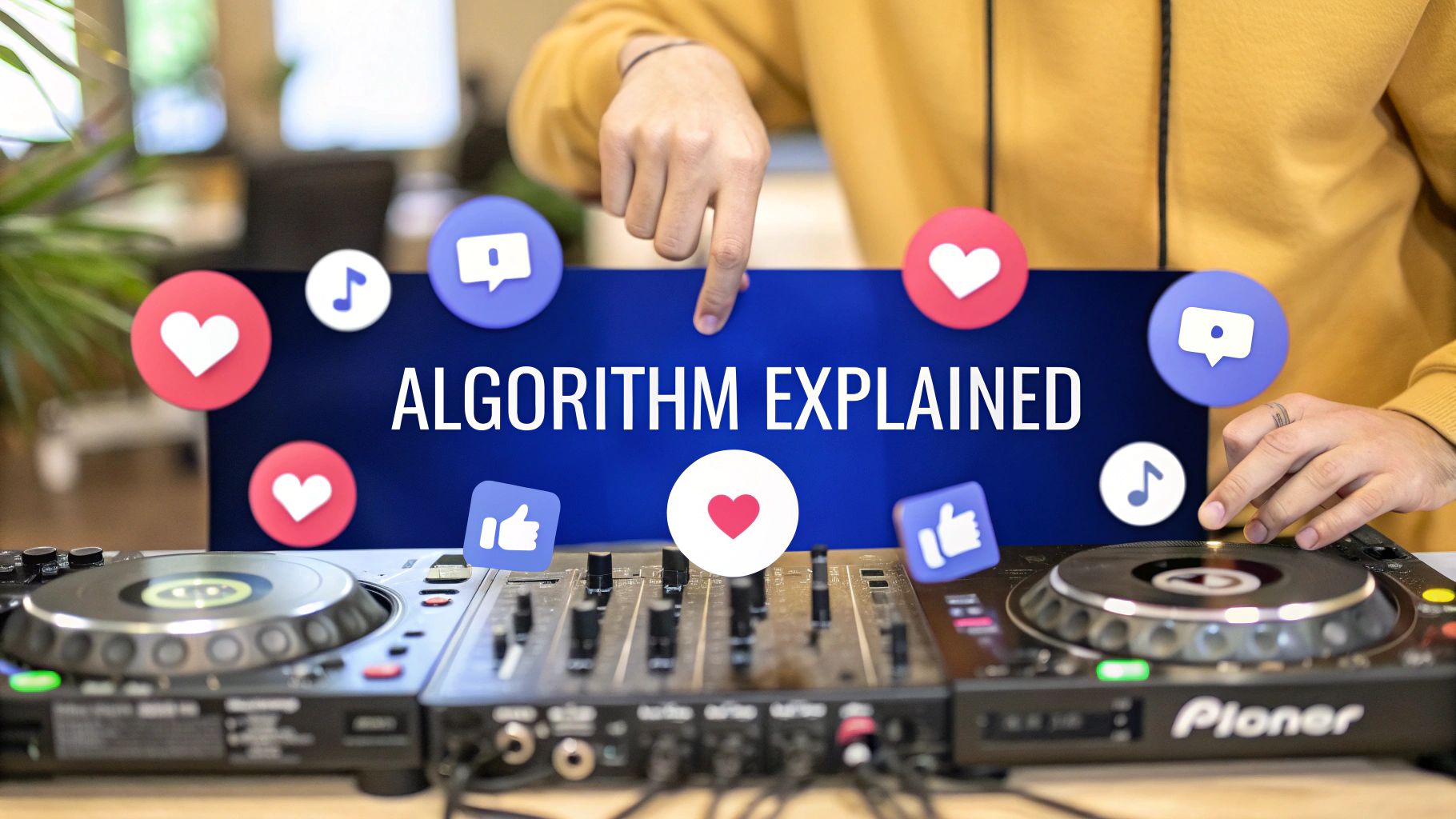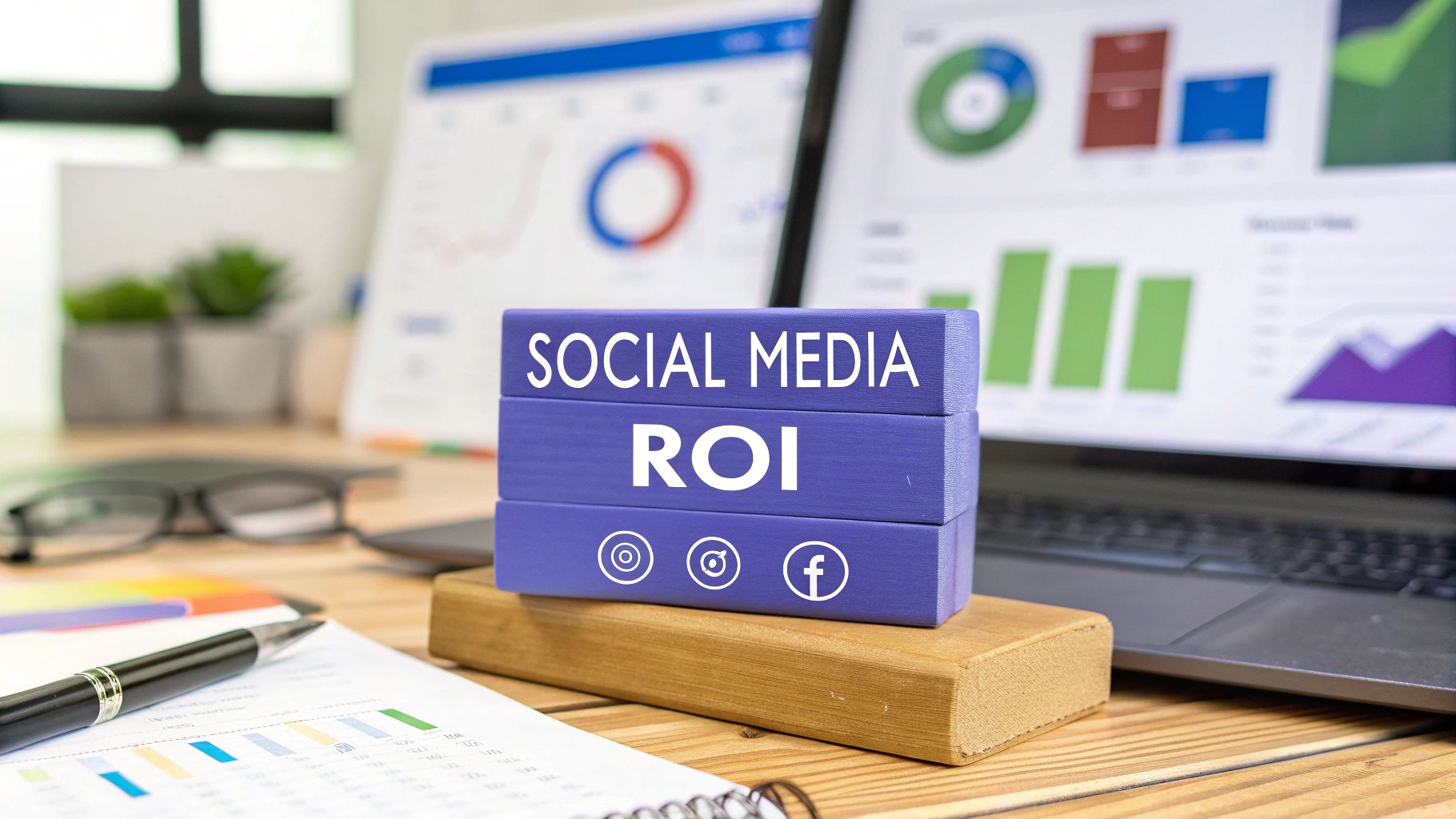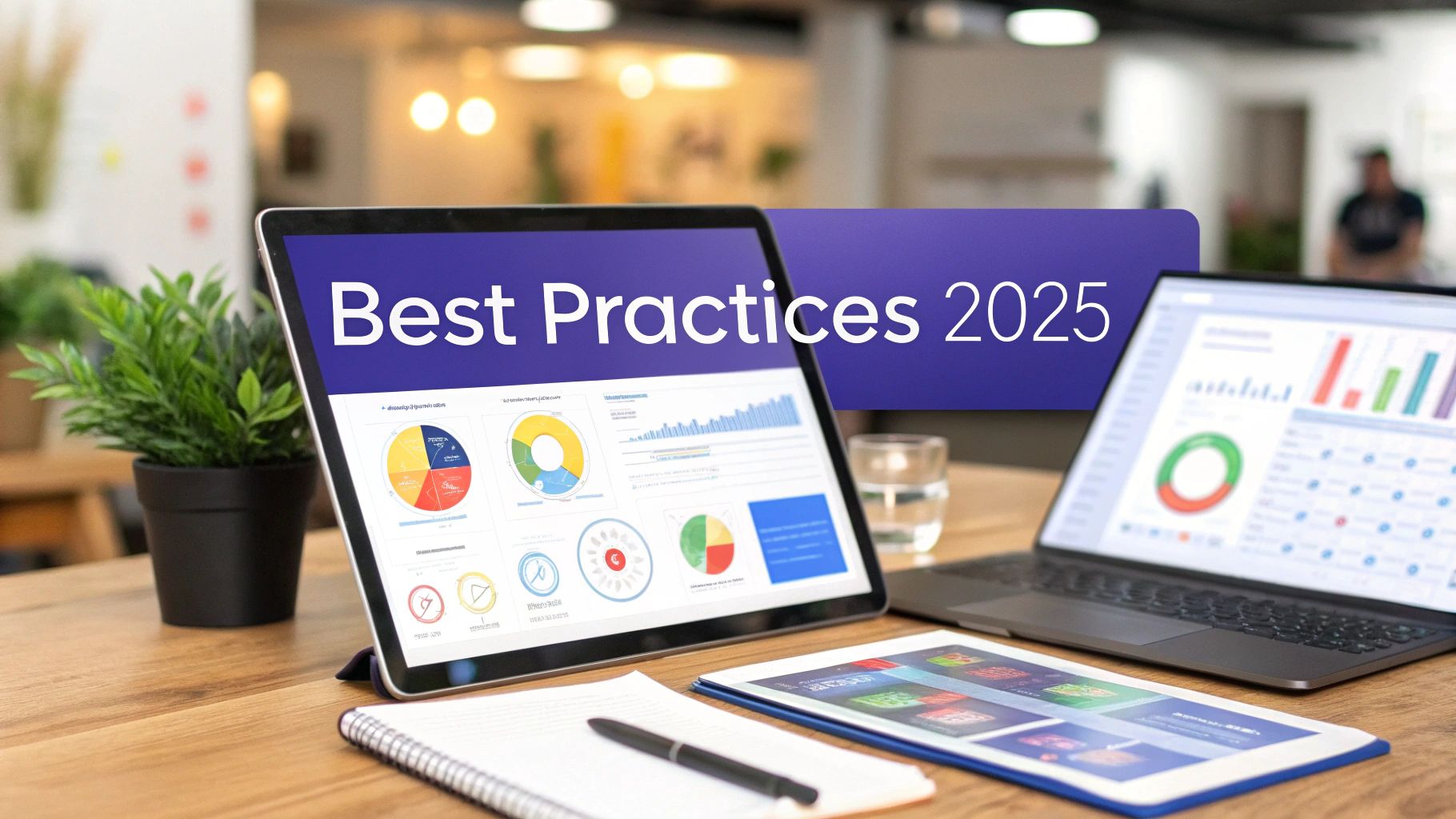You've got two main ways to schedule your LinkedIn posts: either right there on the platform itself or by using a third-party tool like PostSyncer for a bit more firepower. This lets you get your content calendar locked in, saves you from the daily scramble, and makes sure your posts land at the exact right moment for maximum impact.
Why Scheduling LinkedIn Posts Is a Strategic Move
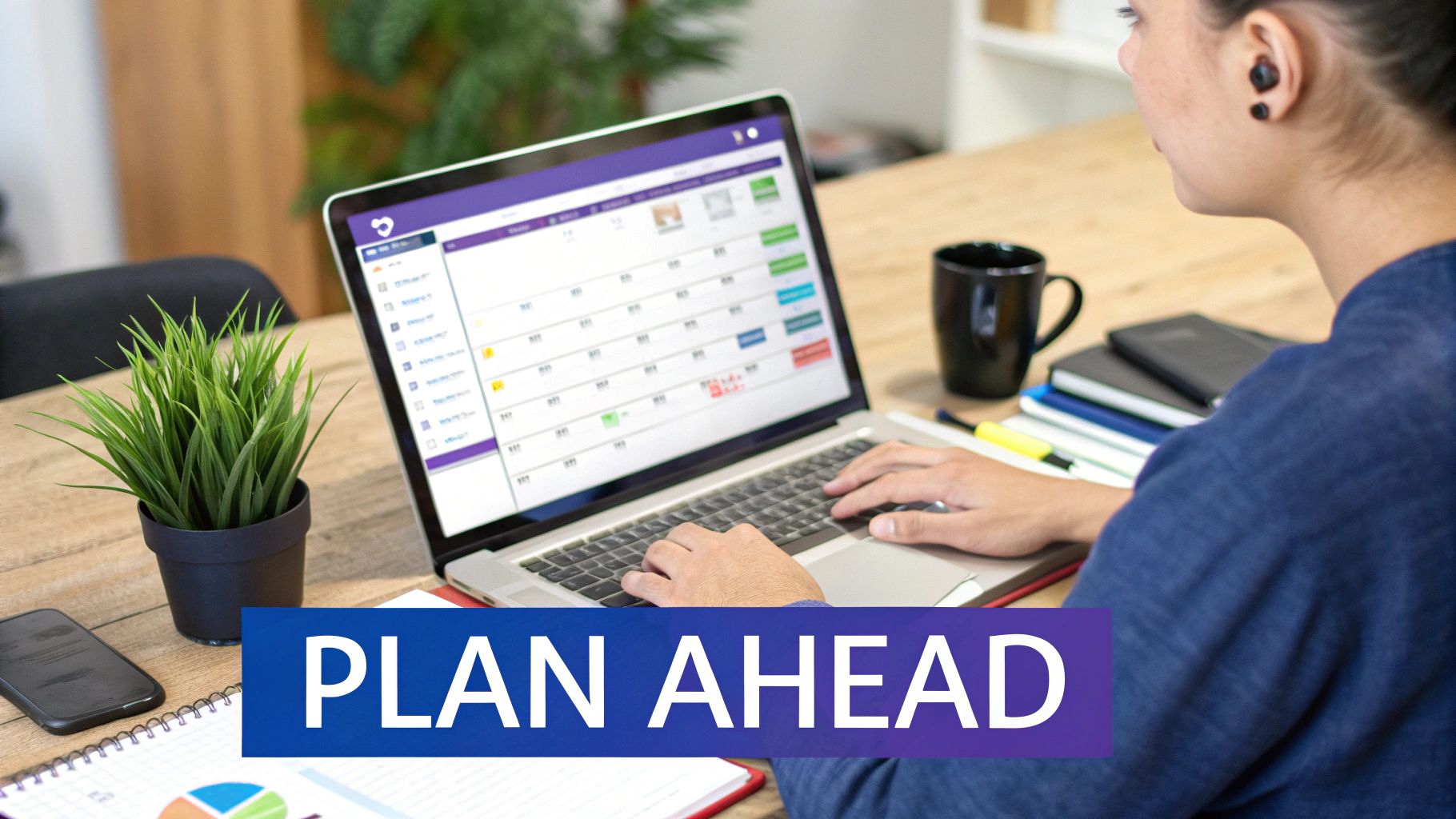
Let's be clear: knowing how to schedule posts on LinkedIn is about more than just saving a few minutes. It's a real strategic edge for anyone who's serious about building a professional brand or growing their business on the platform. In a feed that’s more crowded than ever, consistency is what separates the noise from the signal and builds trust with your audience.
Scheduling is what makes content batching possible. You can block off a few hours to create a whole week's—or even a month's—worth of high-quality content all at once. This approach completely dodges that last-minute panic to find something to post, which almost always leads to weak, uninspired updates. Instead, you can be thoughtful and make sure every post ties back to your bigger goals.
Amplify Your Reach and Impact
Imagine you're a consultant trying to land clients in different countries. Are you really going to wake up at 2 AM to post just to catch an audience in another time zone? Of course not. That's not a sustainable strategy. Scheduling solves this problem neatly, making sure your message shows up when your audience is actually online and ready to listen, no matter where they are in the world.
This has become even more critical with recent algorithm shifts. After the 2025 "Nexus" update, a post's initial lifespan was slashed to just 2-4 hours. This makes getting timely engagement right out of the gate absolutely essential for gaining any real traction. With LinkedIn now home to over 1.2 billion users, scheduling your posts for peak hours in your audience's local time zones isn't just a nice-to-have; it's a must-do for maximizing your reach.
Key Takeaway: Scheduling flips your LinkedIn strategy from being reactive to proactive. It puts you back in the driver's seat, giving you control over your story, your timing, and ultimately, your professional impact.
By planning your content out, you're also putting some of the best asynchronous communication best practices to work. Your message can connect with people at the best possible times without you having to be chained to your desk. This smart approach is really the foundation of effective digital outreach for any modern professional or brand.
If you just want a simple, no-fuss way to plan your content ahead of time, LinkedIn's own scheduling feature is a pretty decent place to start. It's built right into the platform, working for both your personal profile and any company pages you manage, so it's super accessible if you're just dipping your toes into creating a content workflow.
The process itself is refreshingly easy. After you've written your post and added any images or videos, just look for the little clock icon right next to the "Post" button. Give that a click, and a calendar pops up where you can pick the exact date and time you want your post to go live.
Navigating the Native Scheduler
LinkedIn gives you a pretty generous three-month window to schedule your content, which is great for long-term planning. Once you’ve set your time, you get one last look to make sure everything's perfect before hitting the "Schedule" button to lock it in.
Here’s a peek at what that scheduling interface looks like inside the post composer:
As you can tell, it’s clean and intuitive. You just pick the date on the calendar and the time from a dropdown menu. It's designed to be straightforward.
But here's the catch—and it's a big one. If you schedule a post and then notice a typo or want to swap out an image, you're out of luck. You can't directly edit a scheduled post. Your only move is to delete the entire thing and start all over again. Trust me, it’s incredibly frustrating when all you needed was a quick fix.
Pros and Cons of Sticking with LinkedIn
The biggest plus is definitely how seamless it is. There are no extra logins or subscriptions to deal with, and it handles most of the content you'd want to post—text, single images, and videos. For a solopreneur or someone managing just one page, this might be all you need to stay consistent.
The big trade-off is flexibility for convenience. While the native scheduler is free and easy, the inability to edit and the lack of advanced features like a master content calendar mean you might outgrow it quickly.
This single limitation is a major reason why so many professionals and social media managers eventually start looking for more powerful tools. When you're handling multiple accounts, running complex campaigns, or just need better analytics and editing power, the native tool's shortcomings become really clear.
To get a better sense of a more advanced approach, you can learn more about how to schedule LinkedIn posts for maximum engagement in our detailed guide, which covers strategies that go way beyond the basics.
Ready to Level Up? Unlocking Advanced Scheduling with Third-Party Tools
While LinkedIn's native scheduler is a decent starting point, it's a bit like using a basic screwdriver. It gets a simple job done, but you'll quickly discover its limits. When you're ready for more power, efficiency, and real strategic control, it's time to bring in a third-party scheduling tool like PostSyncer, Buffer, or Hootsuite.
These platforms are what transform your content efforts from a simple to-do list into a finely-tuned, well-oiled machine. They move way beyond just basic scheduling.
Imagine having one single, unified content calendar where you can see, plan, and manage posts for LinkedIn, Instagram, and X (formerly Twitter) all in one spot. This is a total game-changer, whether you're a marketing agency juggling multiple clients or a solopreneur who needs a cohesive brand message across every channel.

As the visual above shows, truly successful scheduling isn't just about picking a time and hitting "publish." It’s a complete workflow that combines thoughtful planning with precise execution to make sure your content gets seen by the right people.
Why Advanced Analytics and Collaboration Matter
The real "why" behind these tools isn't just about convenience—it's about gaining access to deep analytics and seamless collaborative features. For the first time, you can actually see which posts are driving clicks, sparking conversations, and growing your audience... and which ones are just falling flat. For any serious marketer, this data is pure gold.
On top of that, team-based approval workflows finally put an end to chaotic email chains and last-minute scrambles. A social media manager can draft a post, and a brand manager can approve it right inside the platform. Everything stays on-brand and error-free before it ever goes live.
The Strategic Shift: Moving to a third-party tool is an investment in insight and efficiency. It’s about understanding your audience on a much deeper level and streamlining your entire content production process, from the first idea to the final publication.
The value of this consistency is backed by hard numbers. LinkedIn boasts a median organic engagement rate of about 8%, making it one of the most effective platforms out there for building a real, sustained audience. Using a robust tool to schedule posts ensures you’re consistently tapping into that potential by posting at the perfect times. Over time, this is how you build a powerful professional reputation. If you want to dive deeper into the data, you can explore Buffer's 2025 social media engagement findings.
LinkedIn Native Scheduler vs Third-Party Tools
To help you decide which path is right for you, here’s a quick comparison. Think of it as choosing between a simple tool for a quick fix and a full-featured toolkit for long-term projects.
LinkedIn Native Scheduler vs Third-Party Tools
A feature-by-feature comparison to help you choose the right scheduling method for your specific needs.
| Feature | LinkedIn Native Scheduler | Third-Party Tools (e.g., PostSyncer) |
|---|---|---|
| Platform Management | LinkedIn only | Multiple platforms (LinkedIn, X, Instagram, etc.) from one dashboard |
| Editing Scheduled Posts | No, you must delete and reschedule | Yes, easily edit content, images, and times |
| Advanced Analytics | Basic post-level metrics | In-depth performance reports, trend analysis, and audience insights |
| Team Collaboration | Not available | Features like approval workflows, team roles, and shared calendars |
| Content Management | Basic scheduling up to 3 months out | Content libraries, evergreen post recycling, and bulk scheduling |
| Cost | Free | Varies, with free and paid plans available |
| Best For | Individuals with a simple, LinkedIn-only posting schedule | Marketers, agencies, and businesses needing efficiency and data |
At the end of the day, the native scheduler is perfect for occasional posting. A dedicated tool, on the other hand, is for building a serious, strategic presence. The ability to edit scheduled posts alone is a massive advantage, saving you from the all-too-common frustration of having to delete and re-upload an entire post just to fix a simple typo.
Finding Your Best Times to Post on LinkedIn
Learning how to schedule LinkedIn posts is only half the battle. The real magic happens when you know when to schedule them. This isn't just about saving time; it's about strategically placing your content right in front of your audience when they're most likely to engage. That’s how you maximize your visibility and impact.
So, where do you start? General data gives us a fantastic baseline. After analyzing over a million posts, a clear pattern emerges: the sweet spot for engagement is on weekdays between 7 a.m. and 4 p.m.
Tuesdays and Thursdays, especially around 10 a.m. and 11 a.m., tend to perform exceptionally well. This makes sense—it’s when professionals are often taking a mid-morning break or catching up after their first round of meetings. In fact, posts on Tuesdays, Wednesdays, and Thursdays see about 34% more engagement than on other days of the week.
Beyond the General Data
But here's the thing: those stats are just a starting point, not a hard-and-fast rule. The most effective strategy comes from thinking critically about your specific audience. A software engineer in San Francisco has a completely different daily rhythm than a finance director in New York.
You have to get into their heads. Ask yourself:
- When does their workday likely begin?
- Are they grabbing coffee or taking a lunch break around a certain time?
- When are they most likely winding down and scrolling through their feed?
Pro Tip: Don’t just rely on broad statistics. Your own analytics are your best friend. Dive into your LinkedIn Page analytics to see when your audience is most active. That data will always be more accurate for you than any industry benchmark.
Getting your timing right is a universal principle for content success, no matter the platform. While we're focused on LinkedIn here, you can find similar tips for finding the best time to upload to YouTube to see how this concept applies elsewhere.
And remember, a powerful schedule is even better when paired with killer content. Don't forget to check out our guide on finding trending hashtags to give your perfectly-timed posts an extra boost.
Common LinkedIn Scheduling Mistakes to Avoid (And How to Fix Them)
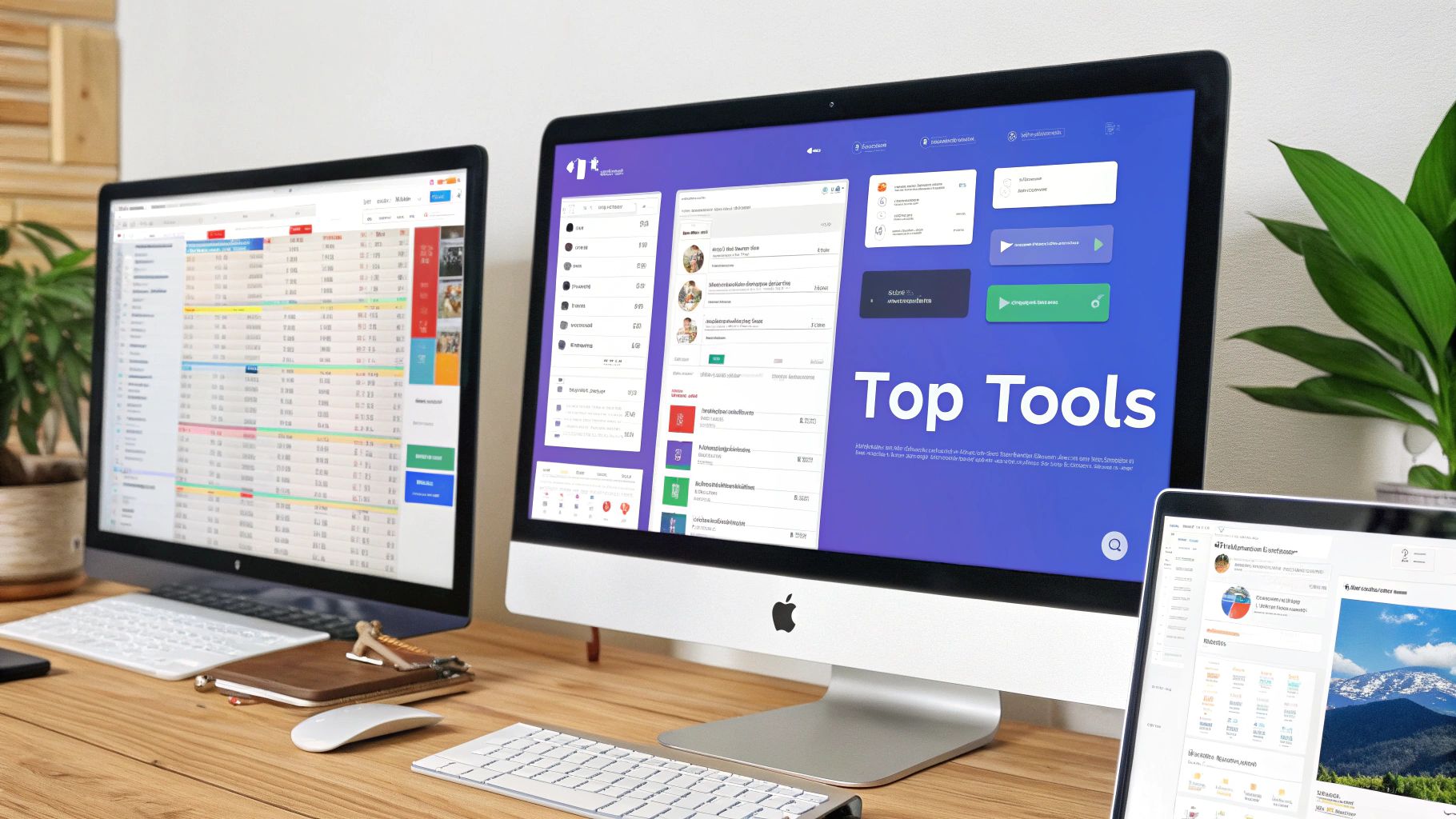
Knowing how to schedule posts is one thing, but knowing how to do it well is what separates the pros from the amateurs. I’ve seen it time and time again: someone gets excited about automation, queues up a month's worth of content, and then completely checks out. This is easily the biggest mistake you can make.
This "set it and forget it" approach is a surefire way to look out of touch. A post that seems brilliant today could be painfully tone-deaf next week if a major industry event or news story breaks. Automation is there to give you a helping hand, not to put your social media strategy on autopilot.
Another classic error? Scheduling a post and then vanishing. That first hour after your content goes live is absolutely critical. The LinkedIn algorithm is watching for those initial likes and comments. If you’re there to reply and get a conversation started, you’re signaling that your post is valuable, which can give its reach a serious boost.
Overlooking What Makes LinkedIn… LinkedIn
It’s tempting to just copy and paste the same content from your other social channels, but this is a huge misstep. A tweet that slaps on X or a story that shines on Instagram will likely fall flat on LinkedIn. Each platform has its own vibe and expectations; your content needs to be tailored for a professional audience to feel authentic.
A couple of other things to watch out for:
- Using generic link shorteners. They can make your post look spammy and erode trust before anyone even clicks.
- Ignoring your analytics. This is like driving with a blindfold on. If you aren't paying attention to what resonates—which topics, formats, and posting times get the most traction—you're just throwing content at the wall and hoping something sticks.
The Real Goal: Scheduling isn't just about saving time or filling a calendar. It's about building a consistent, engaging, and human presence on the platform. A winning strategy means staying involved, responsive, and ready to adapt.
By steering clear of these common pitfalls, your scheduled content will land with the impact it deserves. To take your game to the next level, I highly recommend checking out The Ultimate Guide to Scheduling LinkedIn Posts Like a Pro for more advanced strategies.
Got Questions About Scheduling on LinkedIn?
Even after you've got your tools and strategy sorted, a few questions always seem to pop up about scheduling on LinkedIn. I get it. You want to make sure you're doing everything right. Let's tackle some of the most common ones I hear so you can schedule your content with total confidence.
One of the biggest worries is whether LinkedIn’s algorithm will punish you for publishing through a third-party tool. The short answer is a firm no. As long as you're using a reputable platform like PostSyncer, there's nothing to fear. These tools are built using LinkedIn's official API, which is specifically designed for this kind of integration.
The algorithm is much more concerned with the quality of your content and how much conversation it sparks, not how it got there.
My Two Cents: Stop worrying about getting penalized for using a scheduler. Pour that energy into creating killer content that people actually want to read and discuss. That’s the real secret to winning with the algorithm.
Another classic "uh-oh" moment is spotting a typo right after you've hit "schedule." What can you do?
Can I Edit a Scheduled LinkedIn Post?
This is where your choice of tool really matters. If you're using LinkedIn’s own native scheduler, you’re out of luck. Once a post is queued up, you cannot edit it. The only way to fix a mistake is to delete the post and start over from scratch. It's a real pain for what should be a simple fix.
This is a huge reason why so many of us rely on third-party schedulers. Most of them, including PostSyncer, give you the flexibility to edit your posts right up until they go live. You can tweak the text, swap out an image, or even change the scheduled time. It’s a massive advantage for keeping your content polished and professional.
What Content Can I Schedule on LinkedIn?
Good news here. You can schedule almost all the standard post types you'd create manually. This includes:
- Text-only posts
- Single images
- Multi-image carousels
- Videos
- Documents (like PDFs)
This applies to both LinkedIn's native tool and most scheduling platforms. Just be aware that some of the more interactive, real-time formats like LinkedIn Polls or Events usually need to be created and published live, directly on the platform.
Ready to leave the frustrations of basic schedulers behind? PostSyncer gives you the power to edit posts on the fly, manage all your social channels from a single calendar, and get the analytics you need to fine-tune your strategy. Start your free 7-day trial of PostSyncer today and feel the difference for yourself.













